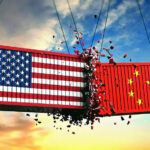As a farmer in the 1960s and early 1970s, Giles Hue-Williams was ahead of his time. On his farm in Little Milton, Oxfordshire, he planted hedgerows and trees in their thousands for their nurturing influence on wildlife and soil, a holistic approach that was rare in an era dominated by industrialisation and monocultural practices. One woodland — of mixed, broadleaf, native species, which he planted on 14 acres of boggy ground not far from the farmhouse — was for his children. The Ordnance Survey map still bears its name: The Sprogs.
A few years later, while working in his orchard, Hue-Williams was killed by a swarm of bees. His son Michael was only seven at the time. Since then, the woodland has held a special significance for Michael, now a gallerist. It became his father’s living legacy, and as he grew up exploring its paths and thickets, it ingrained in him a deep love of trees. Now mature, the woodland brims with ash, oak, beech, poplar and all manner of birdlife, including barn owls and green woodpeckers. Michael Hue-Williams carefully minds it, removing struggling trees and planting many more each year.
Last spring, when an 80ft poplar was struck by lightning, Hue-Williams knew he wanted something more than firewood. This particular species, populus tremula, or quaking aspen, is associated with mourning and the afterlife in various mythologies, due to its white-grey leaves that shimmer in the wind. With his father in mind, Hue-Williams commissioned two artist-designers, Max Lamb and Richard Woods, to work together on Wood, a joint exhibition to immortalise the legacy of the poplar.
Such a commission is not unusual for Hue-Williams. Over a 35-year career he has produced art exhibitions around the world and at Albion Gallery in London, where he put on Ai Weiwei’s first UK show, in 2008. Now based back in Oxfordshire, Hue-Williams — who had planned to follow his father into farming until a teacher persuaded him to apply for a history of art programme at university — has evolved his father’s farm into Albion Barn & Fields, a gallery space where monumental sculptures rise from Grade A agricultural land. Where his father grew crops, Hue-Williams now cultivates art.


Here, adjoining the woodland, in a partially rewilded field frequented by deer, hares and red kites, pieces by Bernar Venet and Erwin Wurm peep from tall summer grass. Half-hidden in a copse lurks a disconcerting Vito Acconci work — a building, really — called “Bad Dream House”. It’s forever being squatted by animals, a nightmare to clean. “Vito wouldn’t put doors or windows on it,” shrugs Hue-Williams. Beside a work by Richard Long, resident geese have made an awful mess.
Hue-Williams wouldn’t have it any other way. “I hate sculpture parks,” he says, pulling up a tuft of ragwort, “but I love the idea of going for a walk and discovering things as you go along.” Art and nature are twin passions for the gallerist, who admires the land artists Richard Long and Andy Goldsworthy because they’ve “understood, they’ve got their feet on the ground”.
Near the middle of the field, a timber pavilion, we come across a cluster of beehives: the outcome of a cathartic moment last year. In the 50th anniversary year of his father’s death, Hue-Williams brought bees back to the family land. “I decided I could forgive the bees,” he says.
In the past he has tried placing sculptures in his father’s woodland, but “the trees just win every time”. Now, for Wood, a tree from the woodland is coming into the gallery. After the poplar was felled, Max Lamb — primarily a designer, whose exploration of materials has seen him cross over into fine art — worked with the green, unseasoned poplar wood to make a table and bowls.
With the help of a woodsman and a terrifying contraption known as an Alaskan chainsaw, Lamb removed two 12.5-metre planks from the middle of the trunk — each a “beast of a piece of material”, he says. Joined side by side, they form a long tabletop that dominates the main gallery space at Albion Barn. He sawed the remainder of the wood into sections, yielding enough raw material for 42 turned bowls the diameter of the tree, decreasing in width as the trunk narrows.
Richard Woods has rather “riffed” on Lamb’s plan. “I like the idea that you start from the same place and go off in different directions, like branches,” he says. Woods has made paintings of Lamb’s bowls and plywood “tree-stump” tables in bright, graphic, wood patterns — a playful signature style that can already be seen on a swimming pool and pavilion on Hue-Williams’ property.
Lamb and Woods also took rubbings of the poplar’s bark just after it had been felled, using wax crayon and a vast piece of paper. This was scanned to become a digital artwork that was printed on to wallpaper and applied to the gallery walls in four different colourways.
Lamb’s contributions to Wood echo his project “My Grandfather’s Tree” (2009), where he divided a beloved ash tree from his grandfather’s garden into 130 sections of equal height which, after very minimal processing, could be used as stools, tables and chairs. The idea was to “give the tree an afterlife”, preserving its identity even as its material served a new function.


Lamb’s bowls for Wood likewise pay homage to the original tree by respecting the natural knots and crotches of the poplar. His brief for the wood-turner was to “remove as little as possible, yet turn them into a bowl”. In a powerful gesture, he positioned the bowls in the gallery on the table so that their grains line up with the wood beneath, creating “an entire tree’s worth of bowls oriented exactly to how they would have been within the tree,” says Lamb.
Wood, says Hue-Williams, is “about the idea of trees resonating”. Faced with an escalating ecological crisis, our relationship with trees appears to be deepening, as evidenced by the national outpouring of grief that followed the felling of the Sycamore Gap tree in Northumberland in 2023 and the popularity of Richard Powers’ million-selling novel The Overstory, which intertwines the lives of various characters with the fate of US forests.
For the author James Canton, both The Overstory and Wood belong to a cultural moment that emphasises closeness and connection between humans and trees. In “seeking ways to be better guardians” of nature, we are looking to trees as “exemplars of ecological responsibility”, says Canton, who spent two years visiting an 800-year-old oak tree for his book The Oak Papers. An oak, he notes, nurtures 2,300 other species, displaying a “level of empathy that we struggle to get near”.
“As humans, we’ve always been close to trees — not just for the shelter, fuel and food they provide,” continues Canton. “Artists and writers can help remind us how we also need trees on other levels — how we are better beside them, how they are essential beings that share our world.”


The title Wood can refer to both the material and a wood, or woodland — and in this sense the exhibition invokes connections not just with The Sprogs but any wood on this tree-depleted isle. Woodland, which Roger Deakin called the “subconscious of the landscape”, plays a special role in our literature as a place of refuge and transformation. Now, as science demonstrates the health benefits of shinrin-yoku, or forest bathing, it is proving what we’ve always known instinctively, says Canton: that “we do feel different when we walk into the woods”.
For Hue-Williams, the magic of trees lies in offering a means of “slow appreciation”, a way of “understanding the passage of time”. Albion Fields is studded with saplings that he has planted for his own children in turn. “You don’t plant a tree for yourself,” he says. “I always encourage people to give each other trees, particularly in significant moments. There’s something unbelievably special about it.”
‘Wood: Max Lamb and Richard Wood’ is now showing at Albion Barn; albionbarn.com
Find out about our latest stories first — follow @FTProperty on X or @ft_houseandhome on Instagram





